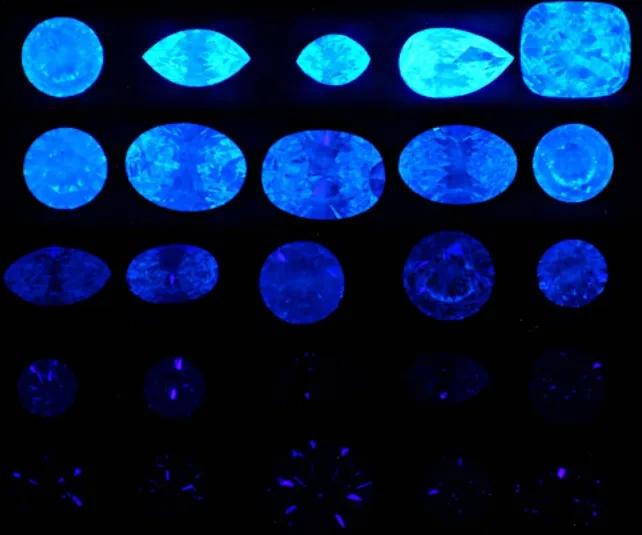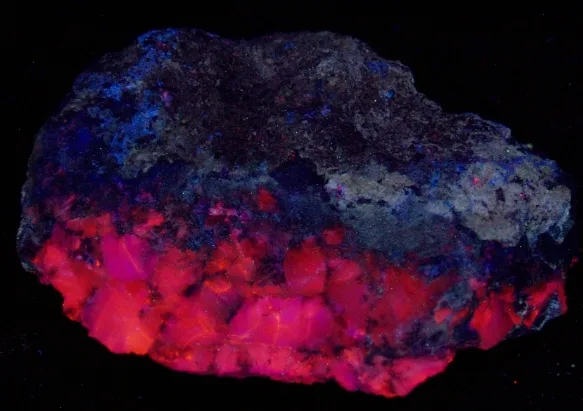Fluorescent minerals are some of nature’s most stunning creations, revealing vibrant colors under ultraviolet (UV) light that are invisible in normal lighting. These minerals contain elements that react to UV radiation, emitting bright hues of red, green, blue, and more. In this article, we explore some of the most spectacular fluorescent mineral discoveries, the science behind their glow, and a comparison of their unique properties.
1. The Science Behind Fluorescent Minerals
Fluorescence in minerals occurs when certain elements, known as activators, absorb UV light and re-emit it as visible light. Common activators include manganese (Mn2?), uranium (UO2?), and lead (Pb2?).
Key Factors Influencing Fluorescence:
- Activator Elements: Essential for light emission.
- UV Wavelength: Shortwave UV (254 nm) often produces brighter fluorescence.
- Crystal Structure: Highly ordered structures enhance fluorescence.
Summary: The glow is a result of activator elements emitting visible light when excited by UV radiation.
2. Types of UV Light and Their Impact on Fluorescence

| Type of UV Light | Wavelength Range | Effect on Minerals |
|---|---|---|
| UV-A (Longwave) | 320–400 nm | Softer, less vibrant fluorescence. |
| UV-B (Midwave) | 280–320 nm | Moderate fluorescence, rarely used. |
| UV-C (Shortwave) | 100–280 nm | Produces the brightest fluorescence. |
Recommendation: For the most vivid mineral fluorescence, use UV-C (shortwave) light.
3. Top Fluorescent Mineral Discoveries
Here are some of the most breathtaking fluorescent minerals discovered around the world:
| Mineral Name | Location | Fluorescence Color | Activator Element |
|---|---|---|---|
| Willemite | Franklin, New Jersey, USA | Bright green | Manganese |
| Fluorite | Rogerley Mine, England | Blue or green | Rare Earth Elements (REEs) |
| Scheelite | Pingwu, China | Blue-white | Molybdenum |
| Calcite | Terlingua, Texas, USA | Red, pink, or orange | Manganese |
| Autunite | Portugal | Yellow-green | Uranium |
| Hackmanite | Afghanistan | Pink to violet | Sulfur |
Summary: Unique activator elements and locations contribute to the spectacular glow of these minerals.
4. The Franklin Mine, New Jersey: A Fluorescent Treasure Trove
Franklin Mine is globally renowned for its exceptional variety of fluorescent minerals, with over 350 species documented, 90 of which are fluorescent.
Notable Fluorescent Minerals from Franklin:
- Willemite: Green fluorescence due to manganese.
- Calcite: Red or pink glow under UV light.
- Hardystonite: Blue fluorescence caused by lead.
Key Insight: The combination of activators and unique geology makes Franklin Mine a hotspot for fluorescent minerals.
5. Comparison of Fluorescent and Non-Fluorescent Minerals
| Aspect | Fluorescent Minerals | Non-Fluorescent Minerals |
|---|---|---|
| Activator Elements | Present (e.g., Mn, Pb, REEs) | Absent or insufficient |
| UV Reaction | Glows brightly | No glow or very faint |
| Crystal Structure | Highly ordered | Often disordered |
| Examples | Willemite, Fluorite, Calcite | Quartz, Feldspar |
Conclusion: The presence of activator elements and a structured crystal lattice are key to fluorescence.
6. Most Spectacular Fluorescent Mineral Sites Worldwide

| Location | Country | Key Fluorescent Minerals | Highlight |
|---|---|---|---|
| Franklin Mine | USA | Willemite, Calcite, Hardystonite | Most diverse fluorescent minerals |
| Sterling Hill Mine | USA | Esperite, Willemite | Known for green and yellow glow |
| Rogerley Mine | England | Fluorite | Famous for daylight fluorescence |
| Langban Mine | Sweden | Calcite, Barite | Unique red and orange hues |
| Pingwu Mine | China | Scheelite | Intense blue-white glow |
Insight: Different geological formations contribute to the diversity of fluorescent minerals.
7. The Role of Impurities and Activators
Impurities in minerals act as activators that enable fluorescence. Common activators and their effects include:
| Activator | Common Minerals | Fluorescence Color |
|---|---|---|
| Manganese (Mn2?) | Calcite, Rhodonite | Red, pink, or orange |
| Uranium (UO2?) | Autunite, Uranophane | Green or yellow-green |
| Lead (Pb2?) | Willemite, Scheelite | Blue or green |
| Rare Earth Elements (REEs) | Fluorite, Apatite | Blue, green, or yellow |
Summary: The type of activator element directly influences the fluorescence color.
8. Common Challenges in Fluorescence Observation
| Challenge | Impact | Solution |
|---|---|---|
| Ambient Light | Reduces fluorescence visibility | Observe in complete darkness. |
| Incorrect UV Wavelength | Fails to excite certain minerals | Use UV-C (shortwave) for best results. |
| Contaminants on Minerals | Blocks UV light absorption | Clean minerals thoroughly. |
Tip: For the best results, use a UV-C flashlight in a dark environment.
9. Summary of Spectacular Fluorescent Mineral Discoveries
| Mineral | Location | Fluorescence Color | Notable Activator |
|---|---|---|---|
| Willemite | Franklin, USA | Green | Manganese |
| Fluorite | Rogerley, England | Blue or green | Rare Earth Elements (REEs) |
| Scheelite | Pingwu, China | Blue-white | Molybdenum |
| Hackmanite | Afghanistan | Pink to violet | Sulfur |
Conclusion: Understanding activators, UV wavelengths, and crystal structures is essential for exploring the beauty of fluorescent minerals.
